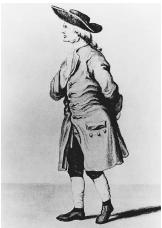Henry Cavendish
ENGLISH PHYSICIST AND CHEMIST
1731–1810

Henry Cavendish, born in Nice, France to an aristocratic English family, was an avid and excellent experimenter. At the age of forty, he inherited an immense fortune that afforded him the luxury of pursuing his scientific interests (he was described by some as the "richest of all the learned and the most learned of all the rich"). He was an extraordinarily odd man, whose extreme shyness rendered him a virtual recluse. Despite this, he is remembered as a great, albeit humble, man who devoted his life to science.
Cavendish explored all areas of science, including astronomy, optics, electricity, geology, and pure mathematics. Among his accomplishments are the first calculation of Earth's mass (his results were just 10% off modern measurements) and the introduction of the concept of voltage . His principal interest nevertheless was experimental chemistry. His most famous contribution to science was the discovery and description of the properties of hydrogen and its status as a constituent element in water.
Cavendish, like many before him, noticed that a gas was produced when zinc or iron was dropped into an acid. He called this gas "inflammable air" (known today as hydrogen). Using his exacting experimental skills, Cavendish was the first to distinguish this inflammable air from ordinary air and to investigate its specific properties. He presented a paper detailing his findings in 1766.
The importance of inflammable air became clear about fifteen years after Cavendish presented his paper. Joseph Priestley (1733–1804) was also interested in gases, and in 1781 told Cavendish of the results of some of his own experiments. When Priestley used an electrostatic machine to spark ordinary air with inflammable air, he noticed that water was formed. Cavendish repeated this experiment, as well as others like it, but using oxygen (or, as he called it, "dephlogisticated air") in place of ordinary air.
Cavendish's results were the same as Priestley's, but he did not publish or present his findings. Sometime before 1783, however, Cavendish did advise Priestley of his results. Priestley told Charles Blagden, secretary of the Royal Society in London, and Blagden in turn informed Antoine Lavoisier (1743–1794) in France.
Cavendish did eventually publish his findings on the formation of water in 1784. But Lavoisier claimed that he had discovered how water was formed—in fact, it was Lavoisier who coined the name "hydrogen," which means "water former." It was not until the mid-nineteenth century, when Cavendish's notebooks were published, that he was given sole credit for discovering that water is composed of inflammable air and dephlogisticated air, or hydrogen and oxygen.
As may be seen in his collaborative work with Priestley in the investigation of the composition of water, Cavendish did not allow his natural shyness to impede his work. The relationship between him and Priestley demonstrates not only Cavendish's devotion to science, but the general cooperative nature of scientific investigation. By sharing the results of their separate experiments, these two great scientists were able to discover the composition of water.
For all of his scientific genius, Cavendish was a pronounced eccentric. He rarely left his house except for weekly meetings of the Royal Society, and even there, despite being one of the most famous scientists of his time, he was known to linger outside the meeting room and enter only when he thought no one would notice. He could barely tolerate the company of women; if any of his female servants happened to cross his path, she was likely to be fired. Though enormously wealthy, he was reputed to own but one suit, and an old-fashioned one at that.
Cavendish lived a lonely and humble life, committed to the cultivation of science. To him, science was measurement, and he showed himself to be one of the most respected experimentalists of the time. His death was as lonely as his life; when he sensed that the end was near, he instructed his servant to leave the room and not come back until a certain time. When the servant returned, he found that Cavendish had died.
SEE ALSO Hydrogen ; Lavoisier, Antoine ; Priestley, Joseph .
Lydia S. Scratch
Bibliography
Berry, Arthur John (1960). Henry Cavendish: His Life and Scientific Work. London: Hutchinson.
Jaffe, Bernard (1976). Crucibles: The Story of Chemistry from Ancient Alchemy to Nuclear Fission. New York: Dover.
Jungnickel, Christa, and McCormmach, Russel (1999). Cavendish: The Experimental Life. Cranbury, NJ: Bucknell.
Internet Resources
"Henry Cavendish." BBC History. Available from http://www.bbc.co.uk .
Comment about this article, ask questions, or add new information about this topic: